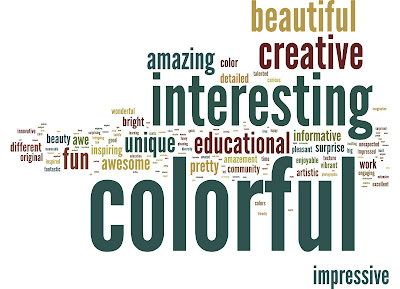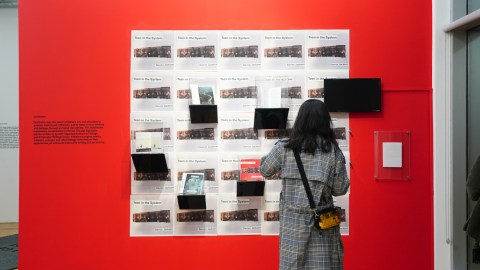This week’s guest post is by Barbara Stauffer, chief of temporary exhibitions at the National Museum of Natural History. This is the first in a series of posts exploring how museums are adapting to people’s desire to contribute, share, manipulate and interpret museum content, in addition to being consumers of (fill in the blank…art, science, history.) We talk about this trend under the heading “MyCulture” in “Museums & Society 2034: Trends and Potential Futures” and have begun to get some non-museum bloggers to share their experiences about interacting with museums and their collections in ways that go beyond the standard museum visit. Barbara kicks off this conversation by telling us about her experience gently nudging the culture of NMNH to accommodate public participation in the creation of an exhibit.
 Hyperbolic Crochet Coral Reef, on display at the Smithsonian’s National Museum of Natural History through April 24, 2011. Photo: Don Hurlbert, Smithsonian Institution |
In many ways, the Institute for Figuring’s Hyperbolic Crochet Coral Reef project was a natural for the National Museum of Natural History.How better to fulfill our mission of “inspiring an appreciation of the natural world and our place in it” than to display these amazing community creations that, when assembled, resembled healthy reefs teeming with color and diversity, bleached reefs in shades of white and gray, and even “toxic” reefs of recycled plastic? But, the Office of Exhibits had never done anything like this before.Would we be able to pull it off?
We knew it would take some time to convince the rest of the Museum of the value of this project.After all, we’re an institution more accustomed to evaluating projects based strictly on scientific merit rather than on artistic value and ability to inspire.Fortunately Nancy Knowlton, Sant Chair for Marine Science, successfully championed the project to her colleagues.
We also wanted to be sure our visitors would understand the exhibition in the context of our Museum, while allowing the installation to speak for itself.Jane Milosch, a curator of craft at the Smithsonian, expertly helped us integrate messages important to the Museum—the biology and conservation of coral reefs—without detracting from the visual and emotional impact of the pieces.
One of the greatest strengths of the Hyperbolic Crochet Coral Reef project is the community component, where community members crochet their own reefs for display locally.We wanted to do the same, but this required funding to hire someone to run workshops and coordinate submissions.Fortunately, we received great support from the Quiksilver Foundation, the Embassy of Australia, and the Coral Reef Alliance.Their sponsorship allowed us to bring on Jennifer Lindsay, who spent six intense months assembling volunteers to create the Smithsonian Community Reef.
We learned quickly that the needs of a community project often run counter to the long-term planning, security, and approval needs of a large federal institution.We weren’t accustomed to designing an exhibition without knowing well ahead of time exactly what we were going to display.Nor were we sure at first that we’d receive any submissions at all!In addition, as a science organization, we had to manage questions and concerns from within the Museum about the accuracy and scientific grounding of the project.Explaining that the installation was designed to be evocative and interpretive rather than literal, I sometimes felt like I was speaking another language.
With the dedication, organizational skills, and diplomacy of Jennifer, as well as Meg Rivers and Catherine Sutera, who coordinated the installation and the programming, we were able to pull it off.Through Flickr.com, Ravelry.com (a fiber arts site), a weekly newletter, and countless workshops held at yarn shops, on the Mall and at the Museum, Jennifer created an incredibly strong community of participants, many of whom continue to be involved with programming at the Museum.Meg managed to navigate our many layers of fire and safety, ADA, script, and other reviews by providing boundaries–like pre-designated platform, panel and case sizes–while allowing for the flexibility needed to respond to last-minute changes inspirations, and hiccups at the end. And Catherine worked closely with our curators, community members, and a dedicated group of participants from our Botany Department to develop educational carts that help explain the relationship of the crochet to the science and actually include scientifically accurate crocheted specimens.
And, was it worth it?Absolutely!
The community response was overwhelming—over 800 participants from around the globe contributed 4,000 pieces to the Smithsonian Community Reef.I still laugh at my early concern that we wouldn’t have enough submissions to fill the 10 by 16 foot platform we had designated for the community portion of the exhibit.Our audience’s response has been positive as well.Preliminary results from a visitor survey show the exhibition has been one of the top rated Smithsonian shows in the last seven years.And, the Natural History Museum community now better understands and embraces the power of innovative, interdisciplinary and participatory exhibitions.
 |
| Created from the five words that 125 interviewees wrote down in February 2011 to best describe their experience of the Hyperbolic Crochet Coral Reef display at the National Museum of Natural History. |
There will never be another Hyperbolic Crochet Coral Reef, but I look forward to taking some of the lessons we learned about engaging a community and visitors with art and carrying those over into future exhibitions and programming.
Has your museum invited the public to help create exhibit content? Did require mind shifts in institutional culture and tradition, and if so, how did you navigate the shoals of change? Please write in to share your experiences.







Barbara- Wonderful on so many levels- a great topic for your museum, the medium, and result. I would love to know if folks thought more or learned more about coral reefs as they whiled away the hours knitting?
I've always wanted to do a knitting show. They are a passionate community with a lot of spare yarn around. A great affinity group to engage for a museum, and inspire other visitors take on challenges.
What a wonderful project! I'm inspired by the inventiveness and am so glad the science-based institution created an art-based project to connect visitors to the content. Very cool!
What was the destiny of the final project? Where did all the knitted pieces end up?